The Influence of Marketing Innovations on Firm Performance under Different Market Environments: Evidence from China
Abstract
:1. Introduction
2. Theoretical Basis and Hypothesis Development
2.1. Marketing Innovation and Business Sustainability
2.2. Effect of Marketing Innovation on Firm Performance
2.3. Moderating Effect of the Market Environment
2.3.1. Market Uncertainty, Marketing Innovation, and Firm Performance
2.3.2. Competition Intensity, Marketing Innovation, and Firm Performance
2.3.3. Technological Turbulence, Marketing Innovation, and Firm Performance
3. Materials and Methods
3.1. Measures
3.2. Data Collection
3.3. Common Method Bias and Construct Reliability and Validity
4. Results
4.1. Main Effects of Marketing Innovations
4.2. Moderating Effect of Demand Uncertainty on Firm Performance
4.3. Moderating Effect of Competition Intensity
4.4. Moderating Effect of Technological Turbulence
5. Discussion
6. Contribution, Limitation, and Future Research
6.1. Theoretical Contribution
6.2. Practical Contribution
6.3. Limitation and Future Research
Author Contributions
Funding
Institutional Review Board Statement
Informed Consent Statement
Data Availability Statement
Conflicts of Interest
References
- Medrano, N.; Cornejo-Cañamares, M.; Olarte-Pascual, C. The Impact of Marketing Innovation on Companies’ Environmental Orientation. J. Bus. Ind. Mark. 2020, 35, 1–12. [Google Scholar] [CrossRef]
- Bartoloni, E.; Baussola, M. Does Technological Innovation Undertaken Alone Have a Real Pivotal Role? Product and Marketing Innovation in Manufacturing Firms. Econ. Innov. New Technol. 2016, 91–113. [Google Scholar] [CrossRef]
- Grimpe, C.; Sofka, W.; Bhargava, M.; Chatterjee, R. R&D, Marketing Innovation, and New Product Performance: A Mixed Methods Study. J. Prod. Innov. Manag. 2017, 34, 360–383. [Google Scholar] [CrossRef] [Green Version]
- Quaye, D.; Mensah, I. Marketing Innovation and Sustainable Competitive Advantage of Manufacturing SMEs in Ghana. Manag. Decis. 2019, 57, 1535–1553. [Google Scholar] [CrossRef]
- Tang, T.; Zhang, S. The Effects of Marketing Innovation on Firm Performance: Market-Driven or Market-Driving? In 2016 Winter Marketing Academic Conference: What Happens in Marketing, Stays Digital-Rethinking Marketing in the Era of Unlimited Data; Hennig-Thurau, T., Hofacker, C.F., Eds.; American Marketing Association.: Chicago, IL, USA, 2016; pp. G31–G32. [Google Scholar]
- OECD. Oslo Manual: Guidelines for Collecting and Interpreting Innovation Data, 3rd ed.; Publications de l’OCDE: Paris, France, 2005. [Google Scholar]
- Gunday, G.; Ulusoy, G.; Kilic, K.; Alpkan, L. Effects of Innovation Types on Firm Performance. Int. J. Prod. Econ. 2011, 133, 662–676. [Google Scholar] [CrossRef] [Green Version]
- Tang, T.; Zhang, S.; Peng, J. The Value of Marketing Innovation: Market-Driven versus Market-Driving. J. Bus. Res. 2021, 126, 88–98. [Google Scholar] [CrossRef]
- Naidoo, V. Firm Survival through a Crisis: The Influence of Market Orientation, Marketing Innovation and Business Strategy. Ind. Mark. Manag. 2010, 39, 1311–1320. [Google Scholar] [CrossRef]
- Soltani, S.; Azadi, H.; Hosseini, S.J.F.; Witlox, F. Marketing Innovation in Rural Small Food Industries in Iran Marketing Innovation in Rural Small Food Industries in Iran. J. Food Prod. Mark. 2015, 21, 533–551. [Google Scholar] [CrossRef]
- Manu, F.A.; Sriram, V. Innovation, Marketing Strategy, Environment, and Performance. J. Bus. Res. 1996, 35, 79–91. [Google Scholar] [CrossRef]
- Bodlaj, M.; Coenders, G.; Zabkar, V. Responsive and Proactive Market Orientation and Innovation Success under Market and Technological Turbulence. J. Bus. Econ. Manag. 2012, 13, 666–687. [Google Scholar] [CrossRef] [Green Version]
- Oke, A. Innovation Types and Innovation Management Practices in Service Companies. Int. J. Oper. Prod. Manag. 2007, 27, 564–587. [Google Scholar] [CrossRef]
- Day, G.S. The Capabilities of Market-Driven Organizations. J. Mark. 1994, 58, 37–52. [Google Scholar] [CrossRef]
- Halpern, N. Marketing Innovation: Sources, Capabilities and Consequences at Airports in Europe’s Peripheral Areas. J. Air Transp. Manag. 2010, 16, 52–58. [Google Scholar] [CrossRef]
- Hills, S.B.; Sarin, S. From Market Driven to Market Driving: An Alternate Paradigm for Marketing in High Technology Industries. J. Mark. Theory Pract. 2003, 11, 13–24. [Google Scholar] [CrossRef]
- Hurley, R.F.; Hult, G.T.M. Innovation, Market Orientation, and Organizational Learning: An Integration and Empirical Examination. J. Mark. 1998, 62, 42–54. [Google Scholar] [CrossRef]
- Johne, A. Successful Market Innovation. Eur. J. Innov. Manag. 1999, 2, 6–11. [Google Scholar] [CrossRef]
- Kumar, N. Marketing as Strategy: Understanding the CEO’s Agenda for Driving Growth and Innovation; Harvard Business Review Press: Boston, MA, USA, 2004. [Google Scholar]
- Moorman, C.; Day, G.S. Organizing for Marketing Excellence. J. Mark. 2016, 80, 6–35. [Google Scholar] [CrossRef]
- Schubert, T. Marketing and Organisational Innovations in Entrepreneurial Innovation Processes and Their Relation to Market Structure and Firm Characteristics. Rev. Ind. Organ. 2010, 36, 189–212. [Google Scholar] [CrossRef] [Green Version]
- Sidhu, J.S.; Commandeur, H.R.; Volberda, H.W. The Multifaceted Nature of Exploration and Exploitation: Value of Supply, Demand, and Spatial Search for Innovation. Organ. Sci. 2007, 18, 20–38. [Google Scholar] [CrossRef]
- Song, M.; Droge, C.; Hanvanich, S.; Calantone, R. Marketing and Technology Resource Complementarity: An Analysis of Their Interaction Effect in Two Environmental Contexts. Strateg. Manag. J. 2005, 26, 259–276. [Google Scholar] [CrossRef]
- Wen, L.; Li, L.; Liu, L. The Relationship between SME Marketing Innovation and Performance. Syst. Eng. 2012, 30, 76–82. [Google Scholar]
- Zhang, F.; Qiu, W. Mechanism and Balance of Exploratory and Exploitative Market-Based Innovation Zhang. J. Manag. Sci. 2013, 26, 1–13. [Google Scholar]
- Zhang, Z.; Zhang, X. Research on Technology Innovation Elements of Enterprise and Its Relationship. Sci. Technol. Prog. Policy 2014, 31, 79–83. [Google Scholar]
- Zhou, K.Z.; Yim, C.K.; Tse, D.K. The Effects of Strategic Orientations on Technology- and Market-Based Breakthrough Innovations. J. Mark. 2005, 69, 42–60. [Google Scholar] [CrossRef]
- Jaworski, B.J.; Kohli, A.K. Market Orientation: Antecedents and Consequences. Dev. Mark. Orientat. 2020, 57, 53–70. [Google Scholar] [CrossRef]
- Narver, J.C.; Slater, S.F. The Effect of Market Orientation on Business Profitability. Dev. Mark. Orientat. 1990, 54, 20–35. [Google Scholar] [CrossRef]
- Damanpour, F.; Evan, W.M. Organizational Innovation and Performance: The Problem of “ Organizational Lag. Adm. Sci. Q. 1984, 29, 392–409. [Google Scholar] [CrossRef]
- Deshpande, R.; Farley, J.U.; Webster Jr., F. Corporate Culture, Customer Orientation, and Innovativeness in Japanese Firms: A Quadrad Analysis. J. Mark. 1993, 57, 23–37. [Google Scholar] [CrossRef] [Green Version]
- Garg, V.K.; Walters, B.A.; Priem, R.L. Chief Executive Scanning Emphases, Environmental Dynamism, and Manufacturing Firm Performance. Strateg. Manag. J. 2003, 24, 725–744. [Google Scholar] [CrossRef]
- Hult, G.T.M.; Ketchen, D.J. Does Market Orientation Matter? A Test of the Relationship between Positional Advantage and Performance. Strateg. Manag. J. 2001, 22, 899–906. [Google Scholar] [CrossRef]
- Johne, A.; Davies, R. Innovation in Medium-Sized Insurance Companies: How Marketing Adds Value. Int. J. Bank Mark. 2000, 18, 6–14. [Google Scholar] [CrossRef]
- Walker, R.M. Innovation and Organizational Performance: A Critical Review of the Evidence and a Research Agenda. In Academy of Management Proceedings; Academy of Management: Briarcliff Manor, NY, USA, 2005; pp. B1–B6. [Google Scholar] [CrossRef]
- Wu, F.; Mahajan, V.; Balasubramanian, S. An Analysis of E-Business Adoption and Its Impact on Business Performance. J. Acad. Mark. Sci. 2003, 31, 425–447. [Google Scholar] [CrossRef]
- Wang, C.-H. The Impact of Market Orientation on Innovation Performance: Does Service Innovation Matter? J. Bus. Stud. Q. 2015, 6, 77. [Google Scholar]
- Li, T.; Calantone, R.J. The Impact of Market Knowledge Competence on New Product Advantage: Conceptualization and Empirical Examination. J. Mark. 1998, 62, 13–29. [Google Scholar] [CrossRef] [Green Version]
- He, Z.L.; Wong, P.K. Exploration vs. Exploitation: An Empirical Test of the Ambidexterity Hypothesis. Organ. Sci. 2004, 15, 481–495. [Google Scholar] [CrossRef]
- Hang, C.C.; Chen, J.; Yu, D. An Assessment Framework for Disruptive Innovation. Foresight 2011, 13, 4–13. [Google Scholar] [CrossRef]
- Gupta, S.; Malhotra, N.K.; Czinkota, M.; Foroudi, P. Marketing Innovation: A Consequence of Competitiveness. J. Bus. Res. 2016, 69, 5671–5681. [Google Scholar] [CrossRef] [Green Version]
- Slater, S.F.; Narver, J.C. The Positive Effect of a Market Orientation on Business Profitability: A Balanced Replication. J. Bus. Res. 2000, 48, 69–73. [Google Scholar] [CrossRef]
- Ungerman, O.; Dedkova, J.; Gurinova, K. The Impact of Marketing Innovation on the Competitiveness of Enterprises in the Context of Industry 4.0. J. Compet. 2018, 10, 132–148. [Google Scholar] [CrossRef]
- Ali, A. Pioneering versus Incremental Innovation: Review and Research Propositions. J. Prod. Innov. Manag. 1994, 11, 46–61. [Google Scholar] [CrossRef]
- Gatignon, H.; Xuereb, J. Strategic Orientation of the Firm and New Product Performance. J. Mark. Res. 1997, 34, 77–90. [Google Scholar] [CrossRef]
- Jansen, J.J.P.; Van Den Bosch, F.A.J.; Volberda, H.W. Exploratory Innovation, Exploitative Innovation, and Performance: Effects of Organizational Antecedents and Environmental Moderators. Manage. Sci. 2006, 52, 1661–1674. [Google Scholar] [CrossRef] [Green Version]
- Ndubisi, N.O.; Dayan, M.; Yeniaras, V.; Al-hawari, M. The Effects of Complementarity of Knowledge and Capabilities on Joint Innovation Capabilities and Service Innovation: The Role of Competitive Intensity and Demand Uncertainty. Ind. Mark. Manag. 2020, 196–208. [Google Scholar] [CrossRef]
- Matusik, S.F. The Utilization of Contingent Work, Knowledge Creation, and Competitive Advantage. Acad. Manag. Rev. 1998, 23, 680–697. [Google Scholar] [CrossRef]
- Rust, R.T.; Ambler, T.; Carpenter, G.S.; Kumar, V.; Srivastava, R.K. Measuring Marketing Productivity: Current Knowledge and Future Directions. J. Mark. 2004, 68, 76–89. [Google Scholar] [CrossRef]
- Zahra, S.A. Technology Strategy and Financial Performance: Examining the Moderating Role of the Firm’s Competitive Environment. J. Bus. Ventur. 1996, 11, 189–219. [Google Scholar] [CrossRef]
- Porter, M.E. Competitive Advantage; The Free Press: New York, NY, USA, 1985. [Google Scholar]
- Tushman, M.L.; Anderson, P. Technological Discontinuities and Organizational Environments. Adm. Sci. Q. 1986, 31, 439–465. [Google Scholar] [CrossRef] [Green Version]
- Wang, Y.; Zeng, D.; Di Benedetto, C.A.; Song, M. Environmental Determinants of Responsive and Proactive Market Orientations. J. Bus. Ind. Mark. 2013, 28, 565–576. [Google Scholar] [CrossRef]
- Podsakoff, P.M.; Organ, D.W. Self-Reports in Organizational Research: Problems and Prospects. J. Manag. 1986, 531–544. [Google Scholar] [CrossRef]
- Podsakoff, P.M.; MacKenzie, S.B.; Lee, J.Y.; Podsakoff, N.P. Common Method Biases in Behavioral Research: A Critical Review of the Literature and Recommended Remedies. J. Appl. Psychol. 2003, 88, 879–903. [Google Scholar] [CrossRef]
- Hair, J.; Black, W.; Babin, B.; Anderson, R. Multivariate Data Analysis: A Global Perspective. In Multivariate Data Analysis: A Global Perspective; Pearson: London, UK, 2010; Volume 7. [Google Scholar]
- Fornell, C.; Larcker, D.F. Evaluating Structural Equation Models with Unobservable Variables and Measurement Error. J. Mark. Res. 1981, 18, 39. [Google Scholar] [CrossRef]
- Chen, Y. Marketing Innovation. J. Econ. Manag. Strateg. 2006, 15, 101–123. [Google Scholar] [CrossRef]
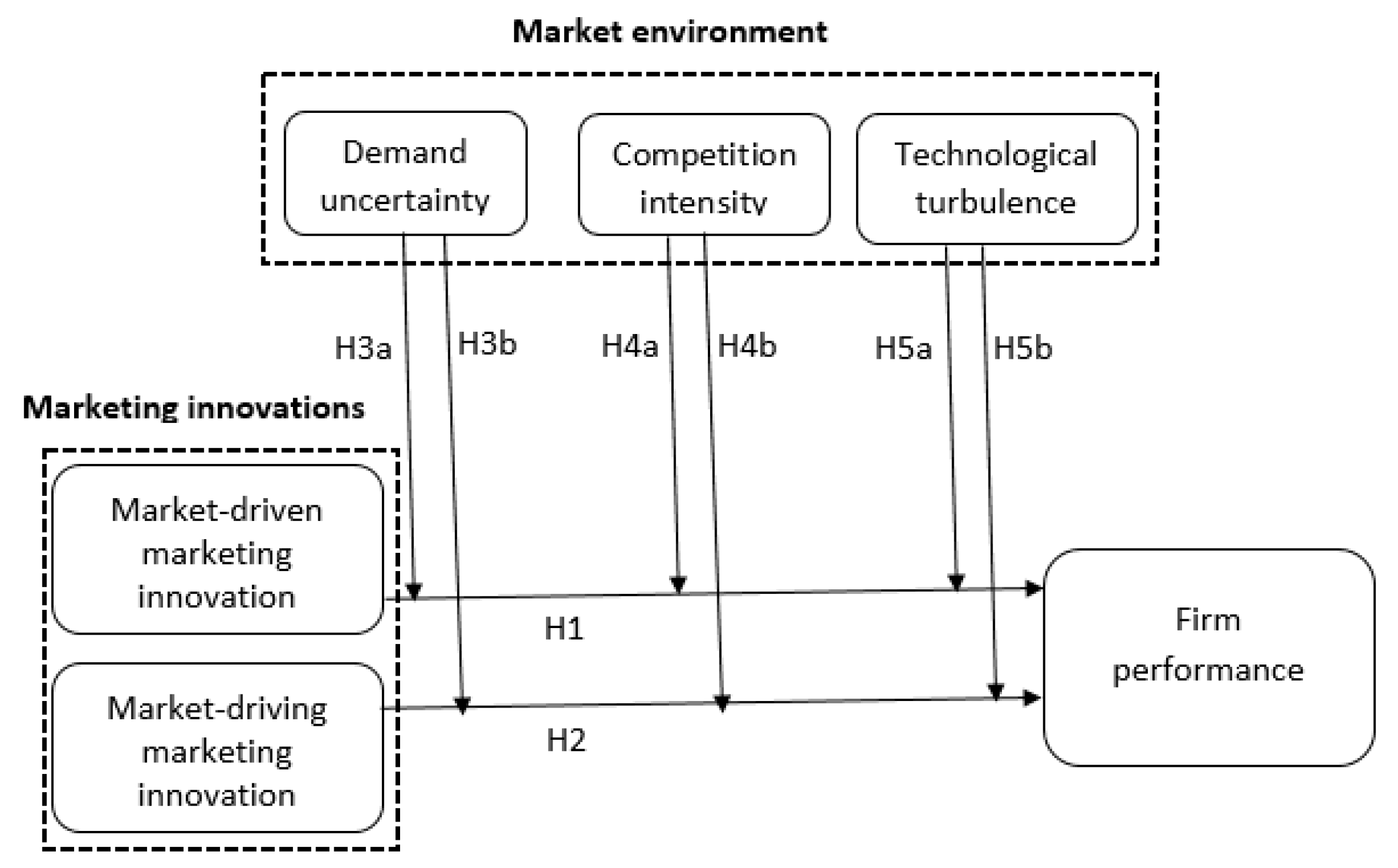
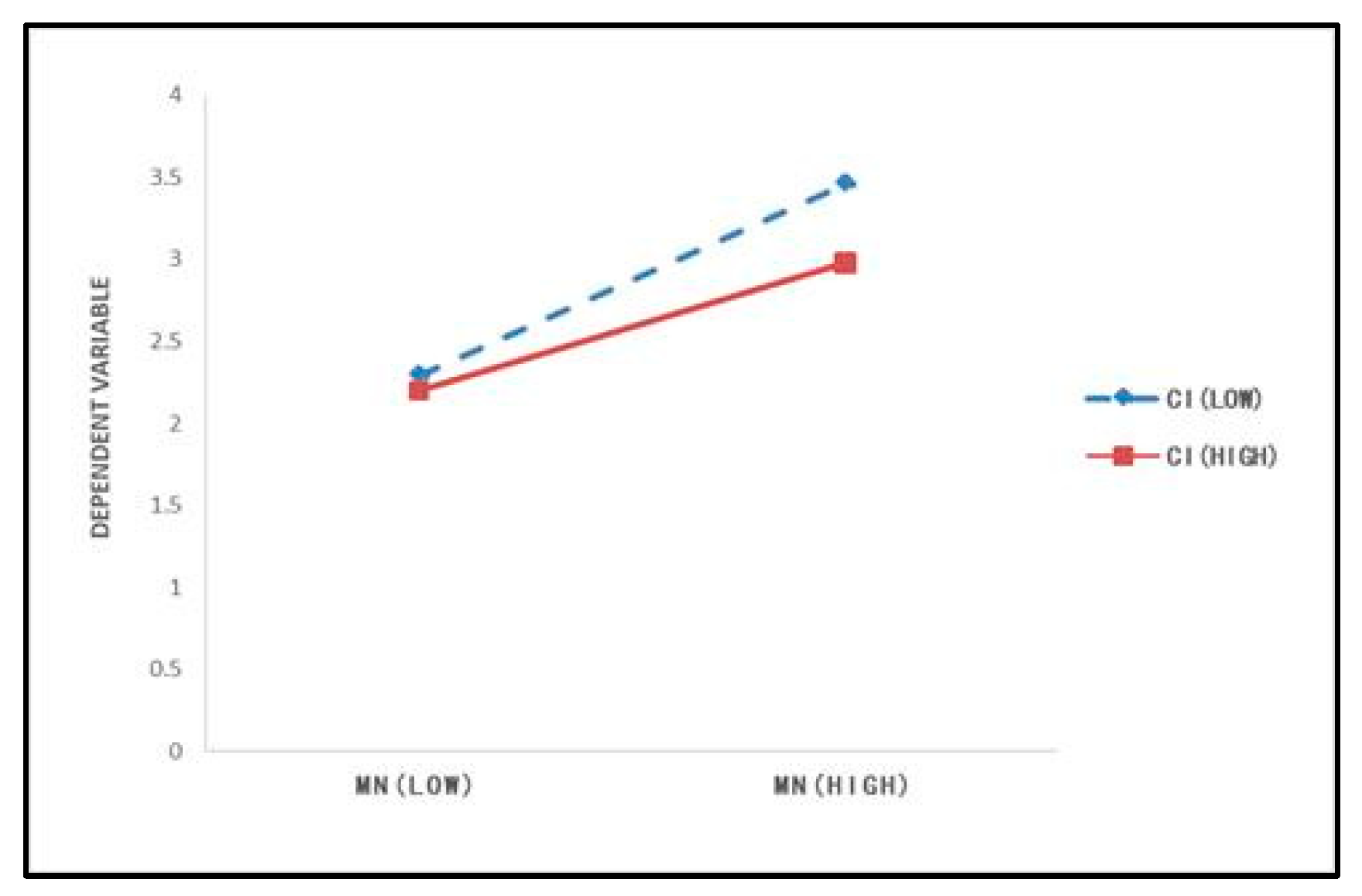
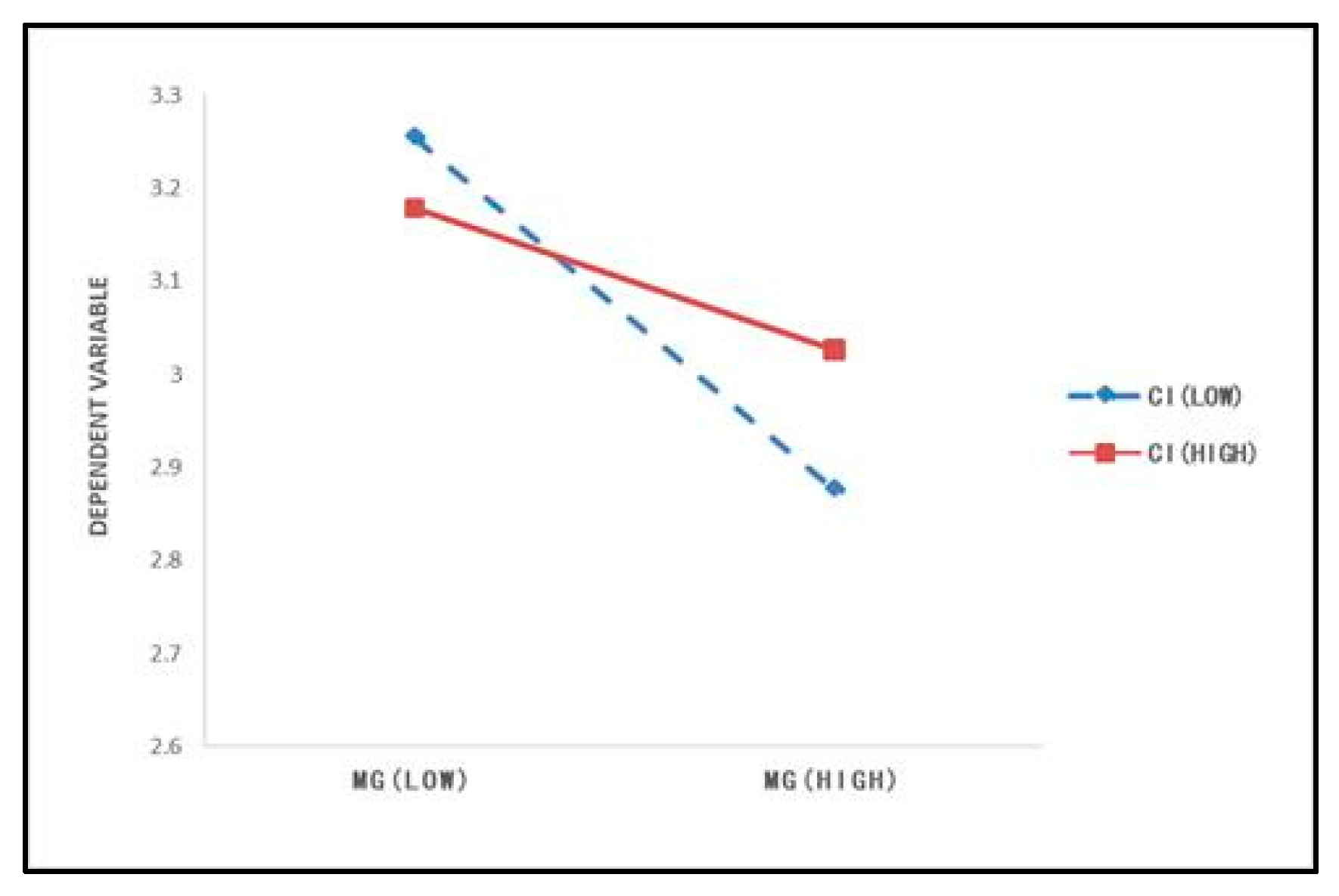
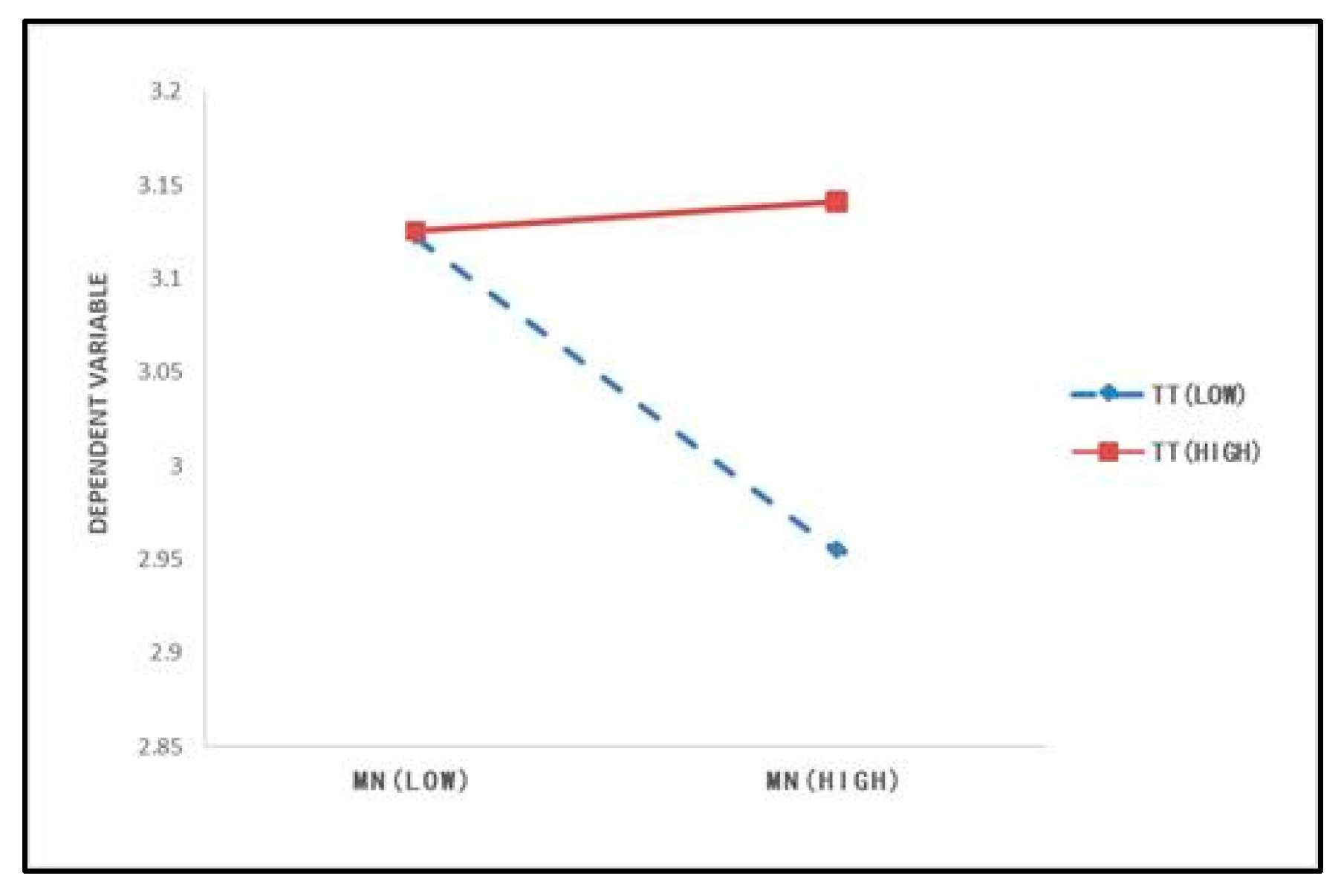
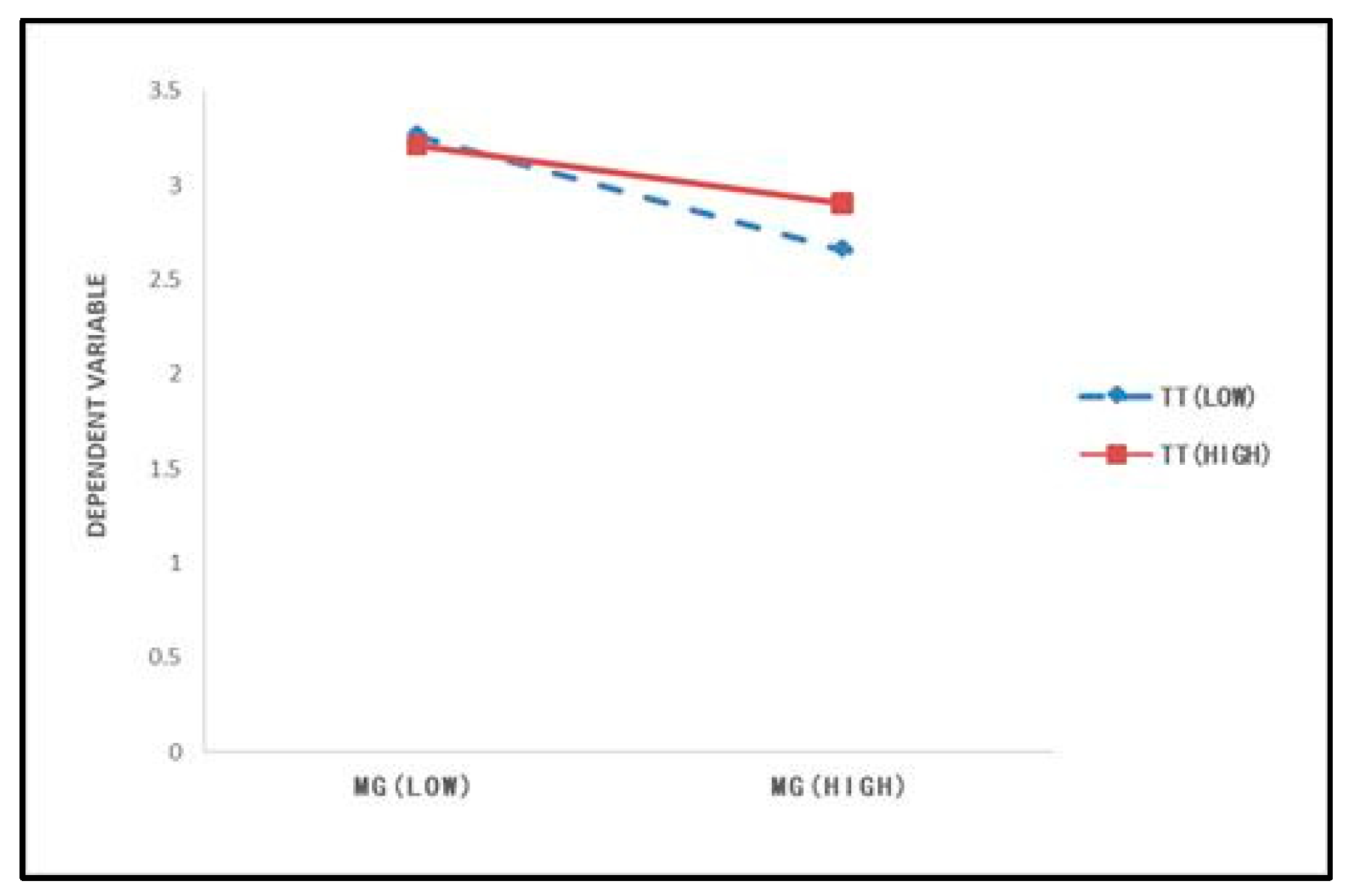
| Market-Driven | Market-Driving | |
|---|---|---|
| Product concept | Existing | New |
| Consumer needs | Expressed | Potential |
| Market segmentation | Existing | New |
| Variables | Source | |
|---|---|---|
| Dependent variable | Firm performance | [42] |
| Independent variables | Market-driven marketing innovation | [9] |
| Market-driving marketing innovation | [19] | |
| Moderators | Demand uncertainty | |
| Competition intensity | [28] | |
| Technological turbulence | ||
| Control variables | Starting time, firm size, market status, and entry barrier | [17] |
| Frequency | % | ||
|---|---|---|---|
| Starting time | Less than 3 years | 40 | 13.29 |
| 3~6 years | 48 | 15.94 | |
| 6~10 years | 50 | 16.61 | |
| Over 10 years | 159 | 52.82 | |
| No response | 4 | 1.33 | |
| Number of employees | Less than 100 employees | 43 | 14.29 |
| 100~500 employees | 52 | 17.28 | |
| 500~1000 employees | 35 | 11.63 | |
| Over 1000 employees | 171 | 56.81 | |
| Industry type | Manufacturing (fast consumption, home appliances, automobile, mechanical manufacturer, electronic components, etc.) | 154 | 51.16 |
| Service sector (telecommunication, finances, IT, consultancy, media, etc.) | 141 | 46.84 | |
| No response | 6 | 1.99 |
| MN | MG | DU | CI | TT | FP | |
|---|---|---|---|---|---|---|
| MN | 0.721 | |||||
| MG | 0.430 ** | 0.815 | ||||
| DU | 0.294 ** | 0.206 ** | 0.831 | |||
| CI | 0.014 | 0.292 ** | 0.254 ** | 0.722 | ||
| TT | 0.294 ** | 0.315 ** | 0.384 ** | 0.322 ** | 0.786 | |
| FP | 0.362 ** | 0.248 ** | 0.247 ** | 0.166 ** | 0.212 ** | 0.799 |
| Mean | 3.765 | 3.325 | 3.065 | 3.261 | 3.222 | 3.513 |
| SD | 0.792 | 0.918 | 1.060 | 0.732 | 0.877 | 0.736 |
| Cronbach’s α | 0.936 | 0.882 | 0.907 | 0.858 | 0.757 | 0.818 |
| AVE | 0.520 | 0.664 | 0.690 | 0.521 | 0.618 | 0.638 |
| Model 1 | Model 2 | |
|---|---|---|
| β | β | |
| Starting Time | −0.310 | −0.244 |
| Market Status | 0.245 ** | 0.208 ** |
| Firm Size | −0.180 | −0.174 |
| Entry Barrier | −0.012 | −0.013 |
| MN | 0.198 ** | |
| MG | 0.113 * | |
| R2 | 0.163 | 0.251 |
| F | 9.96 ** | 11.28 ** |
| ∆R2 | 0.088 | |
| ∆F | 11.810 ** |
| Model 3 | Model 4 | Model 5 | Model 6 | |
|---|---|---|---|---|
| β | β | β | β | |
| Starting Time | −0.219 | −0.214 | −0.242 | −0.228 |
| Market Status | 0.201 ** | 0.191 ** | 0.229 * | 0.227 ** |
| Firm Size | −2.11 | −0.208 | −0.149 | −0.155 |
| Entry Barrier | −0.003 | −0.002 | −0.024 | −0.026 |
| MN | 0.220 ** | 0.117 | ||
| MG | 0.161 ** | 0.092 | ||
| DU | 0.102 * | −0.059 | 0.118 ** | 0.040 |
| MN × DU | 0.041 | |||
| MG × DU | 0.023 | |||
| R2 | 0.256 | 0.257 | 0.245 | 0.246 |
| ∆R2 | 0.002 | 0.001 | ||
| F | 11.53 ** | 9.96 ** | 10.92 ** | 9.39 ** |
| ∆F | 0.66 | 0.36 |
| Model 7 | Model 8 | Model 9 | Model 10 | |
|---|---|---|---|---|
| β | β | β | β | |
| Starting Time | −0.224 | −0.226 | −0.278 | −0.0230 |
| Market Status | 0.090 ** | 0.209 ** | 0.236 ** | 0.231 ** |
| Firm Size | −0.200 | −0.208 | −0.134 | −0.160 |
| Entry Barrier | −0.004 | −0.018 | −0.025 | −0.037 |
| MN | 0.264 ** | 0.739 ** | ||
| MG | 0.184 ** | −0.206 | ||
| CI | 0.102 | 0.638 * | 0.019 | −0.371 |
| MN × CI | −0.146 * | |||
| MG × CI | 0.123 * | |||
| R2 | 0.245 | 0.260 | 0.218 | 0.234 |
| ∆R2 | 0.015 | 0.016 | ||
| F | 10.94 ** | 10.10 ** | 9.38 ** | 8.76 ** |
| ∆F | 4.71 * | 4.423 * |
| Model 11 | Model 12 | Model 13 | Model 14 | |
|---|---|---|---|---|
| β | β | β | β | |
| Starting Time | −0.278 | −0.209 | −0.311 | −0.331 |
| Market Status | 0.202 ** | 0.184 ** | 0.232 ** | 0.228 ** |
| Firm Size | −0.204 | −0.238 | −0.141 | −0.132 |
| Entry Barrier | −0.008 | −0.019 | −0.030 | −0.049 |
| MN | 0.228 ** | −0.106 | ||
| MG | 0.158 ** | −0.329 * | ||
| TT | 0.097 | −0.341 | 0.102 | −0.436 ** |
| MN × TT | 0.116 * | |||
| MG × TT | 0.162 ** | |||
| R2 | 0.248 | 0.264 | 0.208 | 0.255 |
| ∆R2 | 0.016 | 0.049 | ||
| F | 11.08 * | 10.29 ** | 10.10 ** | 11.15 ** |
| ∆F | 4.43 * | 13.68 ** |
| Hypothesis | Decision | |
|---|---|---|
| H1 | Market-driven marketing innovation positively affects firm performance. | Supported |
| H2 | Market-driving marketing innovation positively affects firm performance. | Supported |
| H3a | Demand uncertainty positively moderates the effect of market-driven marketing innovation on firm performance. | Not supported |
| H3b | Demand uncertainty positively moderates the effect of driving-market marketing innovation on firm performance. | Not supported |
| H4a | Competition intensity negatively moderates the effect of market-driven marketing innovation on firm performance. | Supported |
| H4b | Competition intensity positively moderates the effect of market-driving marketing innovation on firm performance. | Supported |
| H5a | Technological turbulence positively moderates the relationship between market-driven marketing innovation and firm performance. | Supported |
| H5b | Technological turbulence positively moderates the relationship between driving-market marketing innovation and firm performance. | Supported |
Publisher’s Note: MDPI stays neutral with regard to jurisdictional claims in published maps and institutional affiliations. |
© 2021 by the authors. Licensee MDPI, Basel, Switzerland. This article is an open access article distributed under the terms and conditions of the Creative Commons Attribution (CC BY) license (https://creativecommons.org/licenses/by/4.0/).
Share and Cite
Peng, J.; Qin, Q.; Tang, T. The Influence of Marketing Innovations on Firm Performance under Different Market Environments: Evidence from China. Sustainability 2021, 13, 10049. https://doi.org/10.3390/su131810049
Peng J, Qin Q, Tang T. The Influence of Marketing Innovations on Firm Performance under Different Market Environments: Evidence from China. Sustainability. 2021; 13(18):10049. https://doi.org/10.3390/su131810049
Chicago/Turabian StylePeng, Jianping, Qun Qin, and Tanya (Ya) Tang. 2021. "The Influence of Marketing Innovations on Firm Performance under Different Market Environments: Evidence from China" Sustainability 13, no. 18: 10049. https://doi.org/10.3390/su131810049
APA StylePeng, J., Qin, Q., & Tang, T. (2021). The Influence of Marketing Innovations on Firm Performance under Different Market Environments: Evidence from China. Sustainability, 13(18), 10049. https://doi.org/10.3390/su131810049






